Grant Heslov’s The Men Who Stare At Goats tells the story of a former U.S. Army member claiming to be a psychic soldier who can, among other things, stop the hearts of animals using only his mind. CIS Hollywood, under the vfx supervision of Thomas J. Smith, realised shots of this so-called power in action, as well as a number of other sequences in the film. Digital fx supervisor Joe Henke talks to fxguide about how the shots were accomplished.
Goats
fxg: Can we start with what I think is your signature sequence of the goat falling over. How did you get started on that shot?
Henke: George Clooney’s character, Lyn Cassady, is proving to the Army that he can stop the goat’s heart by staring at it. Grant Hevlov’s concern and Tom Smith’s concern was that the goat had to be as photorealistic and seamless as possible with the live action goat in the surrounding shots and that it didn’t take the audience out of the moment. It fills the frame and the mechanics and physics of it had to be completely convincing. Tom was on set in Puerto Rico where those shots were filmed. They had a goat trainer on set and, like any filmmaker would want, the original idea was to be able to get something in camera.
But of course they couldn’t train a goat to collapse over and play dead. When goats are startled they do sometimes freeze up and go stiff, but that really wasn’t the kind of thing they were looking for. What we had to show was basically making it look like the goat’s heart had stopped. And that meant creating a CG goat. So Tom took a bunch of photos on set of the real goat and we used that for modelling and texturing and for lighting reference.
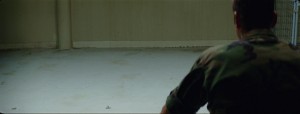
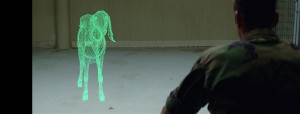
fxg: How did you go about building the goat in CG?
Henke: It was all modelled, rigged and keyframe animated in Maya. We didn’t feel like we needed anything too specific like a rag-doll simulation for the goat falling down. We used the lighting tools in Maya and then rendered in RenderMan. It was a fairly conventional use of RenderMan tools and shaders, but for the fur we used Joe Alter’s Shave And A Haircut. It integrates really well in RenderMan. Also, one of the techniques we used for styling and grooming was to rely on Maya’s Hair to create curves that were then guide hairs for the orientation of the fur in Shave And A Haircut.
Another technique we used was to ray trace all of the fur and ray trace the shadows of the fur. Typically we’d use depth maps, which are rendered out images from the light used to calculate shadows, but by using ray tracing we can get more detail. It takes a little bit longer to render but on this occasion we opted for a better look that we got from ray tracing and global illumination. There was a slight change of focus along the length of the goat, so for depth of field we handled that in compositing by rendering out a depth pass along with passes for the sheen and other things.
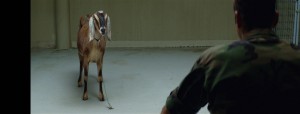
fxg: How did you approach the animation of the collapsing goat?
Henke: We started out with a plate looking over George Clooney’s shoulder. In the shot we wanted the goat to look transfixed, as if it was under George Clooney’s spell, so it had to freeze and hold there for a moment, and then we had the full frame shot of the goat collapsing. The key was to have the chest of the goat lead the fall, as if its heart had stopped, and that was the point of origin of the collapse. And then it was a matter of dealing with some of the mechanics of a quadruped falling.
We did do what we call a model sculpt of our custom models for the goat laying on the ground so we could get the distribution of the belly along the floor to get that shape right, without having to pull in custom muscle deformations. They’re custom model shapes incorporated into the model as blend shapes which we could animate on as it’s landing on the ground.
Hamsters
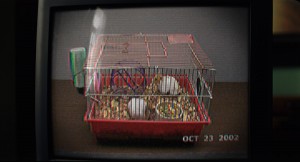 fxg: There are some other collapsing animal shots seen through television monitors too. Did you adopt the same approach for those?
fxg: There are some other collapsing animal shots seen through television monitors too. Did you adopt the same approach for those?
Henke: There’s also a shot of a hamster collapsing inside of a monitor. It involved one of the characters trying to convince someone else with a video tape that a hamster’s heart had been stopped by someone staring at it. So we created the shot and then ran it through an image processor to make it look like an old VHS tape. There’s also another shot of a goat falling and that is seen on a monitor as opposed to full in frame like our hero shot. In both those cases, we went through all the same fur and animation processes as the hero shot, but it obviously was more forgiving in terms of photorealism.
Watch a making-of video breaking down the layers (12 MB).
Choppers
fxg: What were some of the other shots CIS worked on?
Henke: There are a couple of helicopter battle scene shots. One had Hueys from the Vietnam War and the other is a more contemporary Kiowa model of helicopter. We had to model and texture those. We had some digital doubles we would put in the cockpit and man the gun on the side of the Huey. The choppers were modelled in Maya and animated via keyframe.
One of the concerns there was to get the right motion blur look for the helicopter blades. We would look at films like Apocalypse Now and study how the rotors were moving across frame. We also had a couple of shots where they had a practical helicopter with actors jumping out of it. It was an up-angle and we would insert moving CG chopper blades behind them.
Other shots included things like set extensions and fixing up external locations such as for the Iraqi desert scenes. They shot those scenes in the White Sands National Park in New Mexico. We had to do things like remove tyre tracks on the sand, any road markings or anything to indicate that it was an American location. This required a few 3D projections and little fixes to the plate.
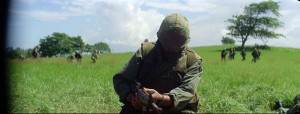
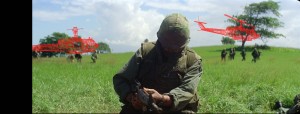
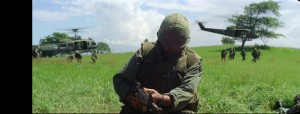
An interesting shot involved the camera entering an underground area of the Army base. It sweeps through one room down a staircase, through some padlocked glass doors, through a dark room and then through another door into a room that’s a pen for the goats. When they shot that they just moved away the glass doors and the camera moved through the space.
We hooked up two shots there and created a CG room to buffer between the two camera transitions in the live action plate. It’s about 600 frames with some voice over narrative. One interesting thing was having to track shots filmed with different focal lengths on the camera. We hooked those two shots up by tracking the B shots with the focal length of the A shot so that we didn’t have a zoom transition which would look strange going through the CG room.
Watch a making-of video breaking down the layers (7 MB).Images (c) 2009 Westgate Film Services, LLC. All Rights Reserved.
Images courtesy of CIS Hollywood.
